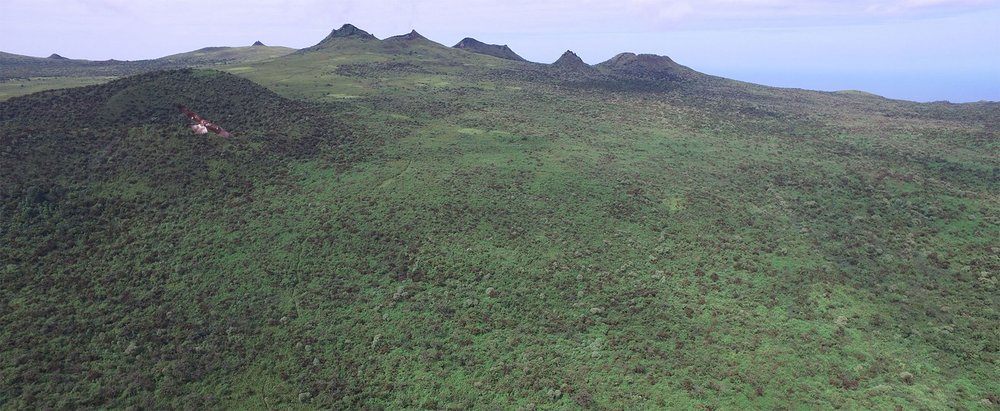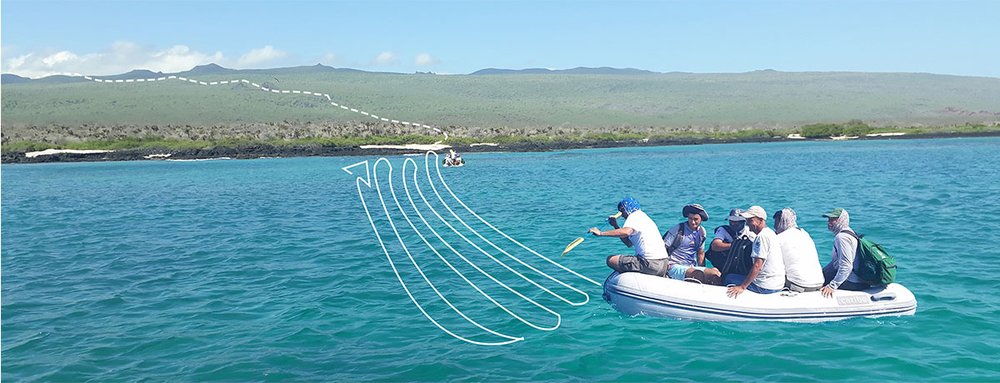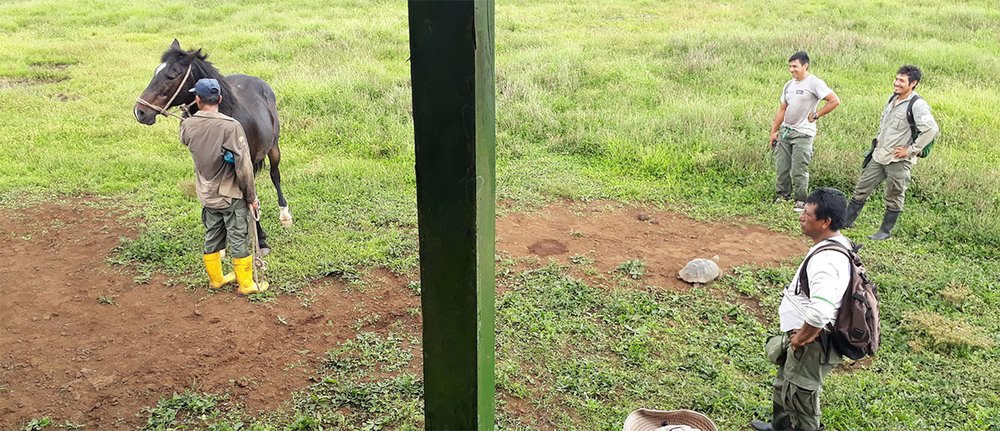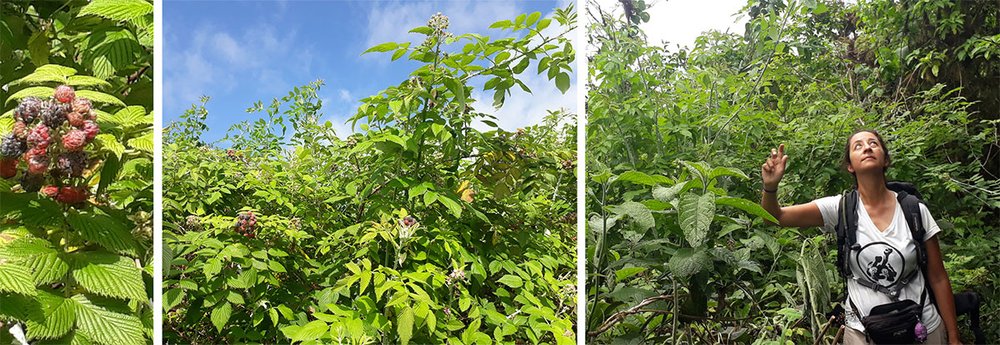
Author: Carolina Carrión
Every year, between February and June, the "hot season" returns to Galapagos. It is during this time, as the haze clears away and the sun shines, that the vegetation mapping project team goes out to fly the drone. In mid-February 2020, the conditions were perfect for one of my favorite field trips: a visit to the highlands of the uninhabited island of Santiago, as part of a trip scheduled by the Galapagos National Park Directorate.
My job in this endeavor was to fly the drone over areas occupied by the invasive blackberry (Rubus niveus), to document its current distribution and compare it with the distribution determined through flights made in the past. It was a successful field trip; both the clouds and the hawks allowed us to fly the drone during each of the seven days that we stayed at the campsite located in the highlands of Santiago. But beyond that, this trip was significant to me because, without knowing, this would be my last field trip before our mobility was restricted due to the COVID-19 pandemic. For that reason, the small experiences, interactions and conversations that occurred during this trip, ended up being much more valuable to me, than they would have otherwise.
We might think that the memories of a field trip are defined by great moments of scientific discovery. But if you asked anyone doing their fieldwork on islands, surely among their most exciting and memorable stories, would be recollections of embarkations and disembarkations. This transition between the boat and the coast, is often more difficult than it seems. On this trip, we had reached our destination at low tide, which meant that the boat could not get close to shore. So, the only way to transport a group of 16 people with all their equipment (cameras, drones, tents, food, etc.) to the coast, was to accomplish it in various trips, using a small zodiac paddled by the park ranger Milton Calva.
On our way to shore, Milton told me about his life in coastal mainland Ecuador, when he used to go out fishing in a small boat. I appreciate very much how, despite several tiring trips back and forth in the zodiac, throughout the entire journey, Milton’s good humor prevailed and he ensured we all arrived safe and sound. His effort is an example of the hard work that many individuals carry out in the field. It is important to acknowledge that without this work, scientific progress would be impossible. During the next few days, the fieldwork was strenuous for the entire team and despite this, the good spirits were kept up, so that at the end of the day, we could play “Ecuavoley”, cook delicious food and tell stories.

A lesson from this experience is that good a humor in the team and good social dynamics between the people who participate in these field trips, are crucial for the success of a field trip. This is because, during our work time, we coexist in limited spaces often in uncomfortable conditions. Sometimes people who participate on a field trip may have very different perspectives, however, working collaboratively is essential to ensure a good work performance and welfare. This is why humor and respect are so important.
I have been thinking a lot about this during our time of quarantine confinement, back on Santa Cruz, and about how important it is to develop these human abilities to better understand each other on a personal and professional level. I realize how vital our participation is in ensuring that our social dynamics allow all of us to feel included, respected and appreciated, both on our field trips and in our daily lives. I also recognize how important it is to create an environment that is free from discrimination based on politics, religion, gender, ethnicity, sexual orientation or physical conditions.

A recurring thought I had during the social distancing caused by the pandemic has been the meaning of the word "quarantine". This is not a new word for those of us who live in Galapagos. We had to quarantine for 72 hours before going to Santiago Island, to make sure that we would not transport seeds or other living organisms that could alter the island’s ecosystems. All members of the trip took their luggage to be inspected and stored. Our non-electronic equipment was kept in a freezer and everything else in sealed cases, fumigated with an insecticide.
Very similar to the quarantine that we follow during this pandemic, the quarantine before a field trip is uncomfortable and, sometimes, the consequences of not doing it are inconspicuous in the short term. However, I believe that in Galapagos, a sense of collective commitment prevails, because we have evidence of how something very small, like a virus or a seed, can wreak serious damage once it invades a space.
An example of this is the invasive blackberry, which was introduced to the Galapagos Islands with the intention of using it as an agricultural crop, but it began to spread rapidly causing negative impacts. It also spread to areas of the Galapagos National Park, and is now a serious pest that is difficult to control. The park rangers know very well how hard it is to control blackberry, because they work to extract the plant manually by pulling it out from its roots, in sites within the protected area. Many of the rangers also work as farmers and are faced with this invasive plant on their farms, as well as other challenges, such as other agricultural pests, freshwater scarcity and a very rocky volcanic soil. The work of the farmers in Galapagos is extremely difficult and valuable, and their food production has provided us with a steady supply during the pandemic, even when the flow of products from the continent decreased.

I find many parallels between the challenges and solutions we face during a field trip and what we are experiencing in this pandemic. As in the transition between the boat and the coast, our transition through this pandemic has not been easy and we have to learn to paddle the boat together. When we cannot row, we have to acknowledge those who do and contribute to the formation of inclusive and fair social dynamics. This is an opportunity to listen to what social movements promoting inclusion and equality are communicating, to contribute with these movements from within our own fields of action, and to disseminate an improved sense of mutual respect. I think there are lessons learned in a field trip like this, that can be applied to our collective transition through this pandemic. Human beings are all part of nature, and we have an opportunity to correct our course and learn to move with the rhythm of nature.

The vegetation mapping project is possible thanks to the support of: DigitalGlobe Foundation, Galapagos Conservancy, Keidanren Nature Conservation Fund, The Frankfurt Zoological Society, Lindblad Expeditions-National Geographic Fund and the BESS Forest Club.





